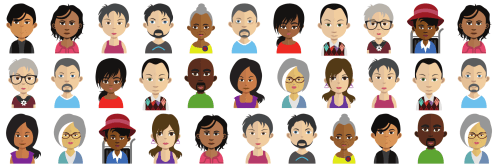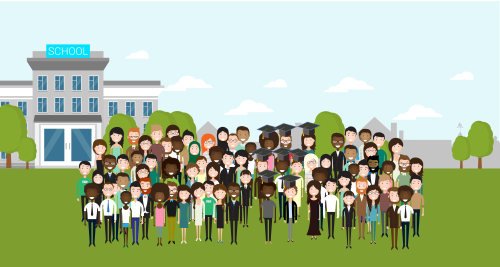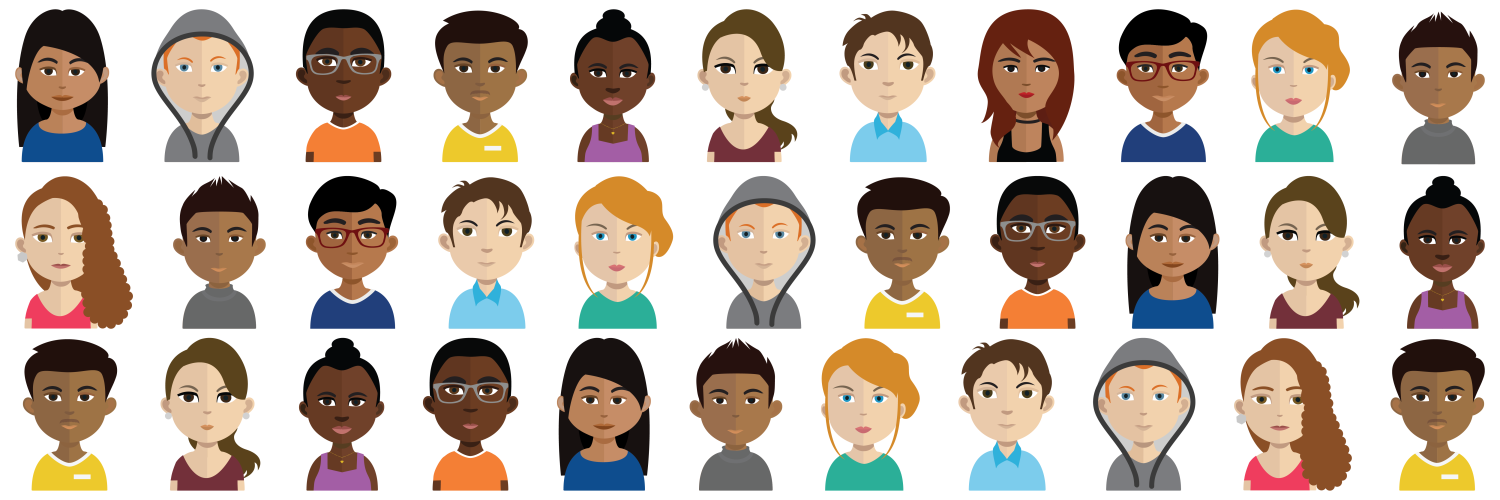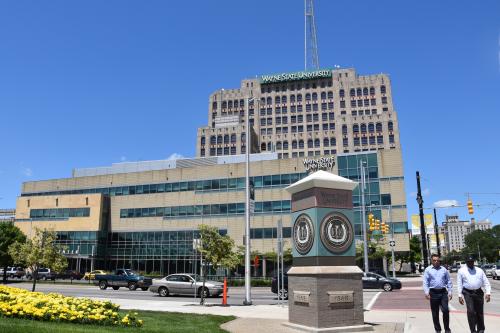Helping young people prepare to engage in work and life as productive adults is a central challenge for any society. In theory, the path to employment providing financial security in adulthood is simple: finish high school, enroll in and complete college or training that is affordable and a good fit, gain some work experience along the way, and launch a career. But given that 17 percent of young adults ages 18 to 24 are out of work in mid to large cities in the U.S., totaling 2.3 million young people, this path does not appear to work equally well for all, particularly in light of the effects of the Great Recession and the declining rates of employment among teens and young adults since about 2000.
Though millions of young Americans are out of work, they are not monolithic. We used cluster analysis to segment out-of-work young adults into five groups, represented by personas included below, likely to benefit from similar types of employment and educational assistance. We grouped young people together based on similarities in their work history, educational attainment, school enrollment, English language proficiency, family status, and other characteristics. Lastly, the report provides recommendations for state, local, civic, and institutional leaders to help all young people successfully navigate the transition into the labor market.
Meet the out of work
For each of the five groups we created in our cluster analysis, we developed two to three fictionalized personas to illustrate young people’s different circumstances and needs.
Avatar grid
Group A
Group B
Group C
Group D
Group E
Dashboard
Re-engagement centers
Re-engagement centers conduct outreach to young people who did not finish high school, assess their academic and life circumstances, and make referrals to “best fit” educational options to earn a diploma or other credential. Such efforts to help young people find their way back to education have expanded across the country in recent years, sometimes as a complement to dropout prevention, or perhaps spurred by public focus on opportunity youth who are neither working nor in school.
The centers are typically part of broader city or state efforts to reconnect young people to good education and training options. While the specifics vary by place, re-engagement efforts involve city governments, school districts, workforce development boards, community organizations, foundations, and others. A census of re-engagement efforts shows growth over the past few years, but a consistent problem in most places is that the availability of educational options falls short relative to need.
Bridge programs
Bridge programs are for people who need additional academic preparation before enrolling in post-secondary education or job training. Low literacy and math levels prevent many adults from succeeding in job training or earning educational credentials, and bridge programs are one response to increase the completion rates of those in need of academic remediation. Some bridge programs focus on preparing for the GED and thus are designed expressly for people without high school diplomas, but others are open to high school graduates as well, depending on their skill levels. Bridge programs often use a contextualized learning approach, in which students develop their academic skills in the context of occupational training or real-world scenarios such as career exploration. I-BEST and Bridge to College and Careers are examples of bridge programs that have been evaluated, but there are many more.
Job training programs that meet local labor market needs and are designed in close consultation with employers
Successful job training programs share a few key characteristics: 1. They offer training (including post-secondary certificates and degrees) and job placement that aligns with regional labor market needs and in-demand skills, and 2. They provide guidance, counseling, and other appropriate supportive services to participants. Additionally, programs for young people particularly strive to develop close relationships between participants and caring adults.
A number of sector-based job training programs have found positive results in recent years (see here, here, and here). Sector-based programs are partnerships among employers, educators, nonprofits, and other stakeholders to identify the workforce needs of particular industries or occupations within a regional labor market. They typically require a baseline level of literacy and numeracy skills (say, reading at the 10th grade level) to assure that students can handle the training and then perform job duties.
Two generation programs
Two-generation programs meet the needs of parents and their children together. Different programs emphasize various aspects of family and economic well-being, with some specifically focused on employment. These provide training to low-income parents along with a variety of wraparound services, such as career coaching and building a peer community, coupled with quality early childhood education for their young children. A two-generation approach is not new, but a fresh wave of programs and energy has emerged in the past five to ten years; see here for more background. A recent evaluation of Career Advance, a two-generation program providing training in the health care field, found positive effects on both parents and children.
Apprenticeships
Apprenticeships take an “earn and learn” approach to education and training: Apprentices earn wages while performing productive work and undergoing supervised, work-based training with related academic instruction. They represent the most structured model of employer engagement in training, since employers hire the apprentices and provide on-the-job training.
An analysis of registered apprenticeships in 10 states found large earnings gains among those who participated. Another study reported that employers participating in registered apprenticeships valued the program and found that it helped meet their needs for skilled workers, while other research identified productivity gains for employers with apprenticeship programs.
While there are a number of youth apprenticeship programs, apprenticeships overall have limited reach when it comes to young people; four out of five apprentices are over age 25 and the average age is 30. In recent years, however, a number of efforts have emerged to develop apprenticeships as an option for young people (for example, see here, here, here, and here.)
Associate or bachelor’s degrees
It is hard to overstate the importance of education beyond high school in today’s economy, and there are countless initiatives to expand college access and improve graduation rates at community colleges, four-year colleges, and universities across the country. These take many forms, but primarily involve changes in how schools organize and offer courses as well as the kinds of academic, financial, and personal supports they offer.
In dual enrollment or early college programs, high school students take college courses and earn college credit while still in high school, thereby easing the transition to post-secondary education. The ASAP program developed by the City University of New York provides a range of supportive services to help students earn an associate degree within three years, including advising, career counseling, tutoring, tuition and fee waivers, and financial assistance for transportation and textbooks. “Guided pathways” reforms at multiple community colleges strive to offer clearer sequences of courses in particular fields of study coupled with stronger advising. Other changes include the growth of online education, competency-based education, and more intentional use of internal data to track student performance and identify points for intervention.
Certificates or certifications
Non-degree post-secondary credentials can also provide real value in the labor market, and have become more common in recent years. These include both certificates and certifications. Certificates are primarily awarded by community colleges or other educational institutions upon completion of a course or series of courses, and certifications are awarded by a certifying body such as a professional or industry group upon successful completion of a test assessing a pre-determined set of skills. Certifications and certificates are commonly earned in fields such as health care, business/office management, cosmetology, auto mechanics, and computer and information services, and many can be earned in a year or less.
Programs targeting the most disconnected young people
Some young people need more support and structure than is provided in other education and training programs. In a synthesis of the research on approaches to improve the employment prospects of young people from disadvantaged backgrounds, MDRC identified the following practices as effective: 1) education and training strongly linked to the job market and career pathways; 2) paid work experience that allows youth to apply skills learned in the classroom, and importantly, provides financial support; 3) supportive services such as case management, mentoring, and assistance with issues such as child care and transportation; and 4) continuing assistance after job placement. Other syntheses emphasize the need for persistent and ongoing outreach, coupled with an intensive case management approach, characterized by one provider as a “bear hug” of wrap-around services. However, relatively few organizations have the mandate or funding to find and engage with these young people compared to the size of the population, making it more likely they will fall through the cracks.
Programs incorporating a combination of the above approaches include YouthBuild, National Guard Youth ChalleNGe, ROCA, and Promotor Pathway.
Close
Interactive by Alec Friedhoff. Design by Alec Friedhoff and Luisa Zottis.
Related Content

Martha Ross, Natalie Holmes
June 22, 2017

Martha Ross, Nicole Bateman
December 1, 2017
2018
Brookings Institution, Washington DC
9:30 am - 11:00 am EDT
Authors




